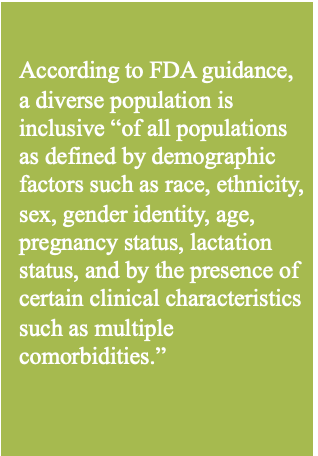The New Era of Diversity Action Plans: Why Integrating Patient Advocacy into Early Clinical Development Is More Essential Than Ever
Consider this: Black Americans account for about 13% of the US population and 22% of yearly cancer cases, but the median enrollment of Black Americans in clinical trials was about 4.5%, according to a 2020 study published in JCO Oncology Practice.
Why does this matter? Because without diverse representation, we are left with large knowledge gaps in how drugs work in large swaths of the population.
In response to these realities, diversity in clinical trials is both a moral and medical imperative for the pharmaceutical and medical device industries. And now, with the passage of the Food and Drug Omnibus Reform Act (FDORA) in 2022, which requires sponsors to include Diversity Action Plans (DAP) with submission of a pivotal trial protocol, it’s also the law.
Putting DAPs into Action
According to Rep. Anna G. Eshoo (D-CA), “The law is both good policy and good science. This is the first time that there is a statutory requirement for diversity in clinical trials. And FDA has made efforts to encourage this since the 1980s. But it’s always been through voluntary guidance. This changes it.”
So, what’s changed? Building on an earlier FDA guidance, which focused on race and ethnicity, the new law also requires that demographic information—such as age, sex, geographic location, and socioeconomic status—be considered in recruitment, and the collection and presentation of data. Starting now, trial sponsors must implement Diversity Action Plans that address:

- Goals for enrollment in the study based on who’s affected by the disease
- An overview of the pathophysiology and epidemiology of a disease or condition
- Current evidence supporting similarities or differences in the disease or condition among underrepresented individuals in clinical trials
- Metrics including actions if goals are not met
- How the sponsor intends to meet recruitment goals through its operational plans
In some cases, the law allows for exemptions if the sponsor can justify a waiver. But for the vast majority, these are now the new rules of the road.
The Crucial Role of Patient Advocacy
As the bridge between industry and patient communities, patient advocacy professional have a crucial role in creating and implementing DAPS that are well designed and successfully executed. Building trust with traditional underserved populations, driving education, identifying non-traditional community-based partners, fostering dialogue and engaging patients early in the clinical development process-all are essential components to achieving diversity in clinical trials that fall squarely in advocacy’s wheelhouse.
Specifically, patient advocacy is uniquely poised to deliver on:
- Assessing the epidemiology of diseases to understand a “representative” patient population.
- Researching demographic and psychographic characteristics of people with diseases to uncover insights in how to reach, build trust, educate and engage successfully, particularly among those who have historically been excluded.
- Conducing landscape analyses to identify community-based organizations that are trusted and effective partners in outreach and support. These could include church groups, local service clubs, food banks, mobile health units and nonprofit urgent care clinics.
- Convening diverse people with specific diseases to discuss challenges and opportunities of trial protocols and participation. Patient advocacy group advisory boards, focus groups or specially-recruited patient councils are just some of the channels to foster these conversations.
- Creating educational programs – for KOLs, community organizations, clinical trial coordinators and company clinical development teams – that address knowledge gaps and perceptions that limit clinical trial enrollment among diverse people.
- Evaluating local support services that can play a crucial role in easing the burden of clinical trial participation, including travel support, bringing trial tests and procedures directly to patients, and supporting meal delivery and other aspects of daily living impacted by trial involvement.
- Co-creating with patients and caregivers communication materials that are culturally and linguistically sensitive and will resonate with diverse patient communities.
There has never been a more meaningful or pivotal time for patient advocacy. Today, more than ever, the special blend of heart and mind that we bring to our work is being summoned to ensure that EVERY patient is heard, cared for, and fully integrated in all aspects of our healthcare system, starting at the beginning by delivering on the promise of increasing diversity in clinical trials. By succeeding here, we ensure that trial recruitment is accelerated, retention is higher and new, innovative treatments are delivered to patients as quickly as possible. A true win-win for patients and drug developers.
